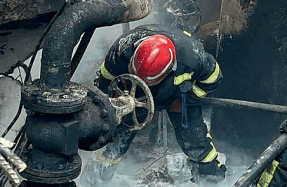
CATHERINE HEYMANS, one of the world’s leading cosmologists, was supposed to board a ferry last September for the northernmost island in the Orkney archipelago. The island, North Ronaldsay, is among the darkest inhabited places on Earth. On a clear winter’s night, it is easy to be awed by the thousands of stars visible to the naked eye. Heymans, who is the first woman appointed astronomer royal for Scotland, had been planning to explain to the 60 or so residents that those stars, and the rest of the perceptible universe, represent a mere fraction of the stuff that makes up our cosmos. What she studies is everything we cannot see: the darkness.
Over the past two decades, Heymans has advanced our understanding of a vast, invisible cosmos that scientists are only beginning to comprehend. That “dark universe” is thought to constitute more than 95% of everything that exists. It is made up of entities more mysterious than the ordinary matter and energy – the light, atoms, molecules, life forms, stars, galaxies – that have been the subject of scientific inquiry throughout history. In the past 10 years, Heymans has learned that the dark universe shapes the visible cosmos in unexpected ways, and may not follow all the standard rules of physics. Her discoveries are unsettling a broad consensus on how our world works on its grandest scales. “I believe that, to truly understand the dark universe, we will need to invoke some new physics that will for ever change our cosmic view,” she has written.
Heymans is not alone in that belief. During the 20th century, scientists developed an extraordinarily precise account of almost 14bn years of the universe’s history. But an increasing number of scientists suspect that model may be broken. Some leading astrophysicists have declared that we have entered an era of cosmological crisis, one that might lead to anything from the discovery of new fundamental particles to a new theory of gravity. “The proliferation of ideas is like nothing I’ve ever seen,” the Nobel prize winner Adam Riess, another key figure in cosmology’s current upheaval, recently told me.
Six months before the scheduled trip to North Ronaldsay, Heymans was like many other world-class scientists: she worked 12 hours a day, with an overwhelming schedule of international travel. In July alone, she was due to attend three international conferences, and to perform Do You Matter?, one of the standup comedy shows that she had been performing with her fellow astrophysicist Joe Zuntz since 2017. Between all that, she was supposed to shuttle back and forth between the University of Edinburgh, where she is professor of observational cosmology, and Ruhr University in Bochum, Germany, where she runs a centre dedicated to exploring the dark universe.
But in March 2022, Heymans and her family contracted Covid. While her partner and three children recovered quickly, she continued to feel awful.




